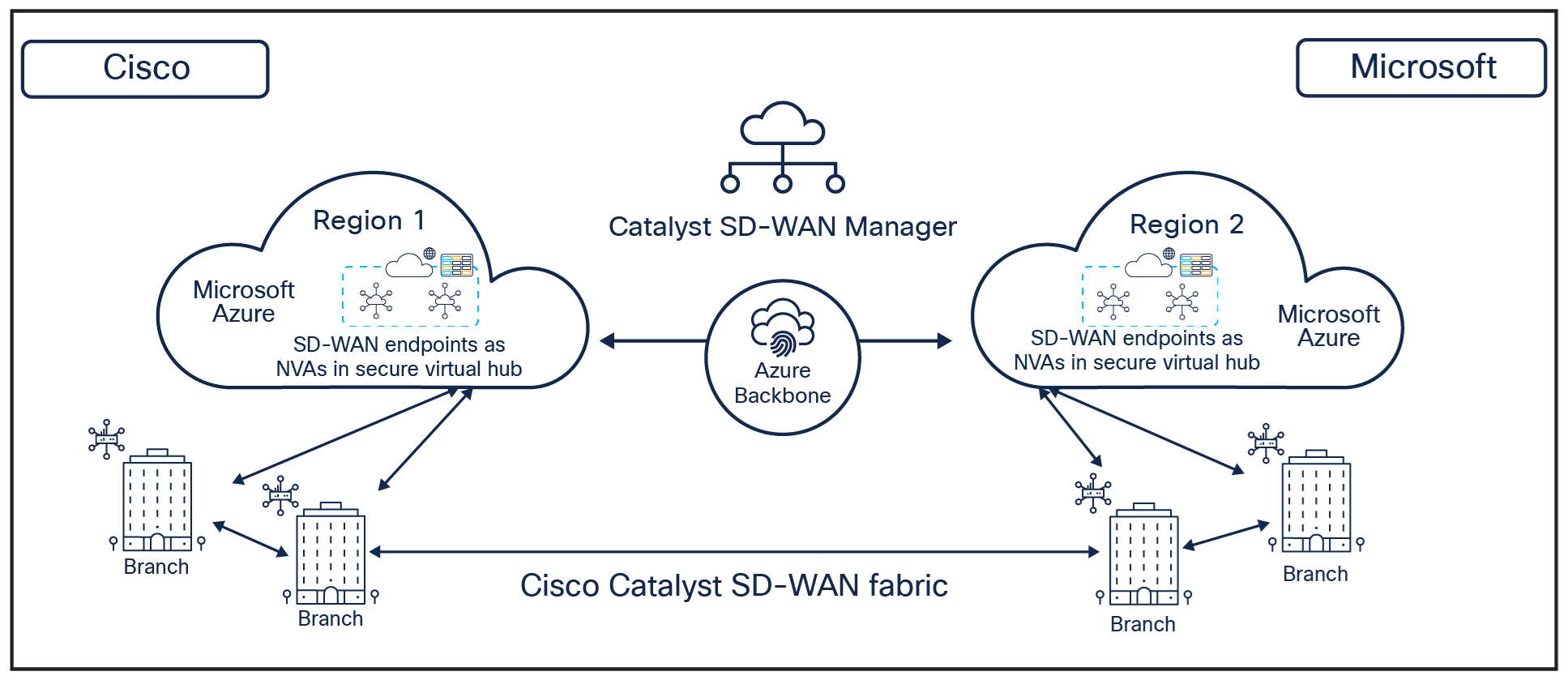Cisco Catalyst SD-WAN with Microsoft Azure Virtual WAN At-a-Glance
Available Languages
Bias-Free Language
The documentation set for this product strives to use bias-free language. For the purposes of this documentation set, bias-free is defined as language that does not imply discrimination based on age, disability, gender, racial identity, ethnic identity, sexual orientation, socioeconomic status, and intersectionality. Exceptions may be present in the documentation due to language that is hardcoded in the user interfaces of the product software, language used based on RFP documentation, or language that is used by a referenced third-party product. Learn more about how Cisco is using Inclusive Language.
Building a modern transit architecture
As enterprises bring in more cloud and cloud-hosted applications, there’s an increasing need for agile connections between globally distributed sites. Cisco is working to make the unused global backbone capacity in the public cloud available to enterprises to use for intersite connectivity. With Cisco Catalyst™ SD-WAN, you can now securely extend your fabric to the public cloud and automate global site-to-site connectivity.
Cisco and Microsoft have partnered to provide a fully integrated, automated solution—Cisco Catalyst SD-WAN with Azure Virtual WAN. You can seamlessly extend your SD-WAN fabric between branch sites and on-premises data centers to the Microsoft Azure cloud. This modern transit architecture allows you to deploy SD-WAN network virtual appliances (NVAs) in Microsoft virtual hubs and extend your SD-WAN to Microsoft Azure cloud with “any-to-any” secure connectivity.
This modern transit architecture allows you to deploy SD-WAN network virtual appliances (NVAs) in Microsoft virtual hubs and extend your SD-WAN to the Microsoft Azure cloud with “any-to-any” secure connectivity between enterprise on-premises sites and Azure virtual networks (VNets).
● Complete automation: The solution is completely automated, thus eliminating the need to manually bring up or configure NVAs or virtual hubs as well as establish site-to-site connectivity on the Microsoft global backbone network. Cisco Catalyst SD-WAN with Azure Virtual WAN does it for you.
● Interregional connectivity: Virtual hubs are all connected to each other over a virtual WAN, which implies that a branch, VNet, or user connected to a local hub can communicate with another branch or VNet using the full mesh architecture of the connected hubs.
● Global site-to-site connectivity: The solution allows customers to leverage the high-speed Microsoft global backbone network as a transit to establish SD-WAN connectivity from a site in one region to a site in another region with Cisco SD-WAN Multi-Region Fabric.

Cisco Catalyst SD-WAN with Microsoft Azure Virtual WAN integration
Interregional, site-to-cloud, and site-to-site connectivity
Cisco Catalyst SD-WAN with Azure Virtual WAN leverages built-in automation to establish on-demand interregional, branch to cloud, branch to data center, or data center to cloud connectivity. Whether the applications are residing in the data center or in a cloud or have a hybrid environment, Cisco Catalyst SD-WAN is built for all. Interregional connectivity supports workloads that are both local and spread across the globe.
Unique capabilities of the solution include:
Built-in resiliency: Azure Virtual WAN provides enhanced resiliency for the NVAs, as it leverages the same resiliency and orchestration features as other native networking services in the Azure Virtual WAN, so if one NVA goes down, Azure will bring up another instance of it in the same virtual WAN hub.
Higher speed and bandwidth: The solution configures and supports Cisco Catalyst 8000V Edge Software instances as NVAs inside Azure virtual hubs, which provides higher speeds and bandwidth, up to 40 Gbps, to enterprises across their global sites.
Firewall service chaining: Native integration in Azure allows for service chaining capabilities and easy bring-up of services as and when needed. The solution is validated with the Azure firewall as well, so customers can easily secure traffic going from branch to VNet, VNet to branch, branch to internet, and VNet to internet using the Azure firewall.
Telemetry and analytics: The close partnership between Cisco and Microsoft allows for sharing of telemetry information and easy monitoring of the health of NVAs in the Azure analytics dashboard, thus enhancing troubleshooting capabilities.
Learn more with these resources:
● Cisco Catalyst 8000V on Azure Marketplace Listing.
● Modern Transit Architecture with Cisco Cloud OnRamp for Azure Virtual WAN White Paper.
● Cisco Catalyst SD-WAN Cloud OnRamp with Multicloud for Azure Virtual WAN How To Demo Video.
● Cisco Catalyst SD-WAN Cloud OnRamp Configuration Guide.
● Cisco DNA Software for SD-WAN and Routing Ordering Guide.